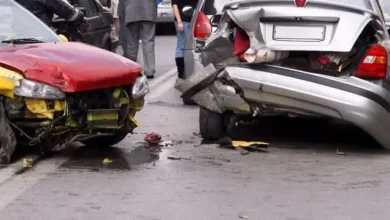Why Are Rear-End Collisions So Common on Texas Highways?

Every day, rear-end collisions happen with regularity on Texas highways. While you might think this type of crash is more common at an intersection or in a parking lot, highways are a frequent location.
According to Brownsville personal injury lawyers, there are a variety of causes behind these types of accidents on the highways throughout the state. Understanding the reasons why they occur can help you stay more aware and avoid becoming involved.
Common Causes of Rear-End Collisions on Texas Highways
It’s important to note that there are a variety of driver error-related causes that lead to rear-end accidents on the highway.
Distracted Driving
An inattentive driver is one of the most dangerous types of drivers on the road. When traffic is at a stop-and-go pace, some drivers may look at their phones, fiddle with the radio, or become engrossed in their thoughts. Any action while in the driver’s seat that causes a driver to take their hands off the wheel, put their focus somewhere other than the task of driving, or take their eyes off the road is a distraction.
Some distractions may seem benign, such as eating, adjusting the music on the stereo, or even talking to passengers. However, it is imperative that your focus be firmly on the road. If you’re not paying attention, you could slam into the back of the vehicle in front of yours.
Tailgating
On the highway, some drivers seem to think that following too closely to the vehicle in front, or tailgating, is the way to get them to speed up and get out of the way. Failing to maintain a safe following distance is a dangerous move. If the vehicle in front needs to stop suddenly because of traffic ahead or a road hazard, there will not be enough time or distance to brake. There should always be enough room to react to sudden changes.
Foul Weather Conditions
The weather might be beyond your control, but the way you adjust to its intensity can keep you safe. When heavy rains or fog roll in, visibility can be reduced in seconds. The biggest mistake drivers make in inclement weather is to continue at their current pace. Even if the speed limit is 50mph, going at that speed when the rain is heavy and the roads are slick can be a recipe for disaster. If you continue going at that speed and other traffic has slowed down to accommodate the change in the weather, you might rear-end another vehicle.
Speeding
There are some drivers who take the speed limit as a mere suggestion rather than the law. When drivers go beyond the speed limit, it puts everyone in danger. If traffic has stopped ahead, the severity of a rear-end crash can be extreme when the driver who causes it is going too fast.
Driver Fatigue
The sprawling highways that connect Texas mean that some drivers have a long journey ahead of them. With the various scenery blending together, it can make any driver feel fatigued behind the wheel. When you need to travel far on the highway, take frequent breaks to stay alert. Fatigue can be just as dangerous as getting in the driver’s seat after drinking.
Drunk Driving
Drunk drivers have slower reaction times, and as such, they may fail to notice that traffic on the highway is slowing down. This can cause them to crash into the rear end of the vehicle in front, and if they’re speeding as well, the outcome could be fatal.
Failing to Maintain a Vehicle
Every driver has a responsibility to keep their vehicle ready for the road. Regular maintenance ensures that brakes, tires, and lights are functional. A driver who fails to maintain their brakes and rear-ends another vehicle on the highway will be considered negligent.
Unexpected or Sudden Stops
When traffic grinds to a halt on the highway, some drivers might not stop in time. It could be due to distraction, drowsiness, speeding, tailgating, or a poorly-maintained vehicle. Texas highways are infamous for their heavy congestion, and all drivers should take heed with the expectation that they may need to stop for slowed traffic ahead.
What Are the Legal Implications of Rear-End Collisions in Texas?
In the majority of rear-end crashes, the driver in the rear is usually at fault. There are rare scenarios where the driver in front may have caused the accident. For any driver involved in such a crash, documenting what happened with photos that show the position of the vehicles, getting witness statements, and calling the police to the scene are critical steps.
Determining Fault in a Rear-End Crash
Texas uses modified comparative negligence when determining fault. Since the rear driver is most often the one at fault in these scenarios, it is less likely that if you were the one rear-ended, you will be blamed for any part of it.
The Process of Insurance Claims
Regardless of who caused the accident, you’ll need to alert your insurance company about the incident. You’ll want to file a claim with the other driver’s insurer. It may seem cut and dry, considering their policyholder rammed into you on the highway, but you might be surprised to learn that the insurer could also try to blame you. Getting legal advice is a good step to avoid getting a lower settlement than you deserve.
Steps to Take After a Rear-End Collision on a Texas Highway
Since accidents are so sudden, you may still be in shock that someone has just plowed into the rear end of your vehicle while on the highway. The next steps are crucial for ensuring justice and financial recovery.
Stay Safe at the Accident Scene
Call 911 to report the accident and check yourself for any injuries. It is best to move your vehicle out of the way if it is still drivable, but don’t move it without taking photos of its position first. Stay out of the flow of traffic and be cautious as other highway drivers move through the area.
Get Medical Care
If traffic were bumper-to-bumper and the person behind you merely rolled into your vehicle, you probably wouldn’t get hurt. However, if they slammed into your vehicle, make sure you have a medical evaluation even if you don’t see any injuries. MRIs and other scans can help detect serious injuries that could become life-threatening without treatment.
Talk to the Police and Exchange Information
All drivers are required to exchange contact information and insurance details with one another after a crash. Even if you think the accident is minor, always call the police. Vehicle damage can cost much more than you think, and if you are injured, having a police report can serve as additional evidence, along with your photos, videos, and any statements from witnesses.
Being alert and watchful on Texas highways can help you avoid these types of scenarios. If you’ve been hurt in a rear-end crash, contact an attorney to help you move forward with your claim and recover a settlement that amply covers your injuries and damages.




